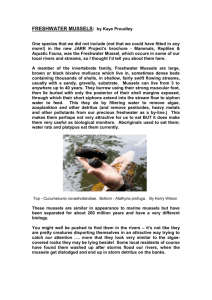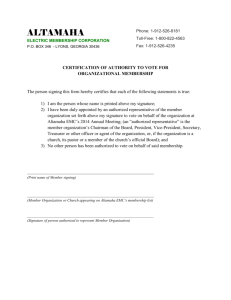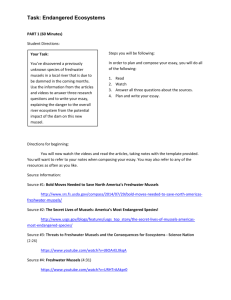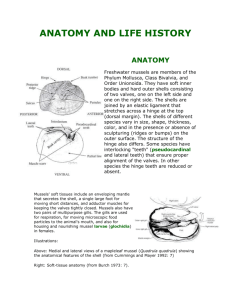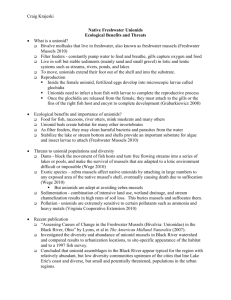NATURAL HISTORY Altamaha Spinymussel Elliptio spinosa
advertisement
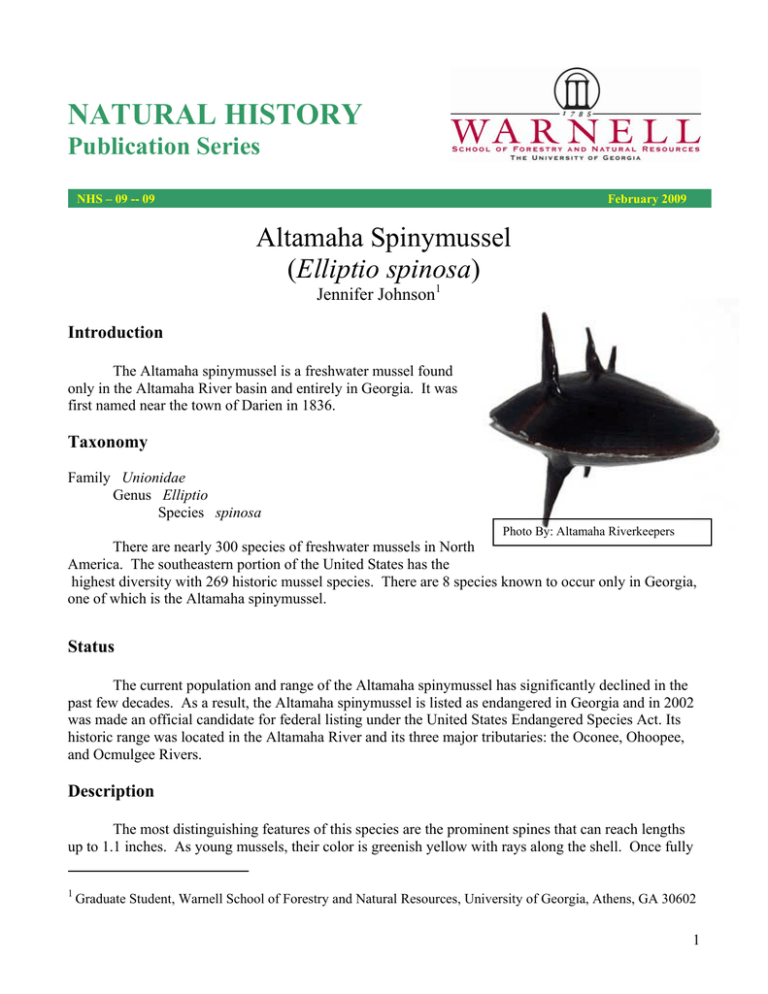
NATURAL HISTORY Publication Series NHS – 09 -- 09 February 2009 Altamaha Spinymussel (Elliptio spinosa) Jennifer Johnson1 Introduction The Altamaha spinymussel is a freshwater mussel found only in the Altamaha River basin and entirely in Georgia. It was first named near the town of Darien in 1836. Taxonomy Family Unionidae Genus Elliptio Species spinosa Photo By: Altamaha Riverkeepers There are nearly 300 species of freshwater mussels in North America. The southeastern portion of the United States has the highest diversity with 269 historic mussel species. There are 8 species known to occur only in Georgia, one of which is the Altamaha spinymussel. Status The current population and range of the Altamaha spinymussel has significantly declined in the past few decades. As a result, the Altamaha spinymussel is listed as endangered in Georgia and in 2002 was made an official candidate for federal listing under the United States Endangered Species Act. Its historic range was located in the Altamaha River and its three major tributaries: the Oconee, Ohoopee, and Ocmulgee Rivers. Description The most distinguishing features of this species are the prominent spines that can reach lengths up to 1.1 inches. As young mussels, their color is greenish yellow with rays along the shell. Once fully 1 Graduate Student, Warnell School of Forestry and Natural Resources, University of Georgia, Athens, GA 30602 1 grown, the spinymussel is rather large for a mussel species. It can reach lengths up to 4.3 inches and is deep brown in color. The inside of the shell (called the nacre) is pink or purple. Form and Function It has been hypothesized that the conspicuous spikes help secure the mussel into the sandy sediments where they are most often found. The spikes could also be a deterrent for predators such as muskrats or raccoons. Ecology Reproduction: Freshwater mussels are bivalves and are long-lived filter feeders that remain in the same stream area for their entire lives - which can be over 100 years! They also have a very unique life cycle. The male mussel releases his sperm into the water column towards the female. The female then uses her incurrent aperture (siphon) to obtain the sperm which then fertilize the eggs that are held in modified gills. The female mussel then can hold her larval mussels, known as glochidia, for a few weeks or even over the winter. However, in order for the glochidia to complete their life cycle and become adult mussels, they need to attach to a fish host to transform into juvenile USFWS Photos. Above is the mussel life cycle Some mussels, such as the spinymussel, release glochidia in packets that resemble aquatic insect larvae that are ingested by fish. Other types of mussels have built in “lures” to attract a potential fish host. The lures usually look like something the fish would likely prey upon such as a minnow or crayfish. When a fish attempts to eat the lure, it gets a mouthful of glochidia. Regardless of the strategy for getting into the fish’s mouth, once there the glochidia attach to the fish’s gills where they are encysted for 2-4 weeks before transforming into juvenile mussels. Soon after transformation, they detach from the fish and settle into the sediment where they will remain throughout their lives. The Altamaha spinymussel is thought to reproduce in late spring. By May or June, the female is ready to release her glochidia. Unfortunately, scientists currently do not know which fish species serve as a host for spinymussel glochidia. However, the Georgia Department of Natural Resources has recently funded a study at the University of Georgia that will hopefully determine the host fish species for this severely imperiled mussel. Feeding: Freshwater mussels are filter feeders and an adult can filter 40 liters of water per day! Adults filter certain types of algae, bacteria and other microorganisms from the water. Behavior: Mussels have limited mobility, meaning they generally do not move more than a few dozen meters throughout their lives. When they do move, it is usually in the summer to avoid drought 2 conditions. During the winter, they tend to burrow and remain inactive until the water temperatures begin to warm. Habitat: Spinymussels are typically found in stable, coarse to fine sandy sediments. They are generally restricted to sandbar areas with high water velocities. Spinymussels are usually found burrowed approximately 2 to 4 inches within the sand. Enemies: Raccoons, otter, and muskrat are known predators of all freshwater mussel species. The Altamaha spinymussel can be vulnerable to predation but given their preferred habitat in swift-moving water, it is unlikely. Human activities pose more of a threat to spinymussels through habitat degradation and certain poor land use practices, such as logging and agriculture. Populations: The population of spinymussels was not systematically assessed until the late 1960’s. Since that time, surveys have shown a steady decline in the spinymussel in the Altamaha and its tributaries. In fact, recent surveys in 2001 did not find any spinymussels in the Ohoopee River and they now are thought to be extirpated from that river. In the Ocmulgee River, since 1993 only 10 of 90 sites surveyed had spinymussels present. Fewer surveys have been conducted in the Oconee River, with only 10 sites surveyed since 1993, but it is thought the spinymussel is extirpated from this river as well. The majority of surveys have been conducted in the Altamaha River. Since 1993, spinymussel populations have been found but in far less numbers when compared to historical records. For example, in 1963 one site found 60 individuals. In the 1990’s and 2000’s the greatest number of individuals found at one site was nine. Disease There is little information on diseases that affect adult freshwater mussels. However, juvenile mussels are highly susceptible to predation by parasites such as nematodes. Economic Value There is no known economic value for this species but historically many mussel species were commercially harvested for use of their shells to make buttons. Currently many mussels are harvested so their shells can be ground up for use as ‘seed’ material for making pearls in oysters. Damage There is no known damage caused by this species. Medicinal Value There is no known medicinal value for this species. Legal Aspects In October 2006, Georgia listed the Altamaha spinymussel as State Endangered. The Georgia Wildlife Action Plan soon followed, listing it as one of the high priority species in need of conservation. Both of these listings are beneficial because there is now a greater likelihood of future funding to study this particular species. The International Union for the Conservation of Nature (IUCN) also has the 3 Altamaha spinymussel listed as Endangered. In 2007, the USFWS determined that threats to the mussel had increased dramatically. Therefore, the danger to this mussel was increased from non-imminent to imminent. This means that the Altamaha Spinymussel will likely be officially added to the US Endangered Species List within the next few years. Control to Reduce There are no current efforts to reduce the population of this species. Other Threats When the Altamaha spinymussel was listed as a candidate for the Endangered Species Act, the US Fish and Wildlife Service needed to assess what was causing the populations to decline so dramatically. Threats were considered and were published in the Federal Register for public viewing. The first threat considered was the “destruction, modification, or curtailment of its habitat or range”. Sedimentation from certain land use practices, such as logging and farming, has been shown to be devastating to mussels. It results in less food availability and respiratory problems. If severe enough, an increase in sediments to a stream could literally suffocate the mussel to death. Preferred habitat of the spinymussel is coarse to fine grain sandbars. Since sediment accumulates on or near sandbars, the problem is compounded for the spinymussel and eventually suitable habitat disappears. Sources of sedimentation have been identified as construction activities, dirt roads, mines, farming, and urban sprawl. Another threat to the mussels’ habitat is industrial effluent (wastewater). Effluent from industrial sources commonly contains toxic substances but also may cause “thermal” pollution. Coal-fired and nuclear power plants use large volumes of river water for cooling purposes, then discharge the warmed water back into the river thereby increasing the downstream water temperature resulting in increased frequency and intensity of algal blooms and lower dissolved oxygen levels. Under Georgia’s Endangered Wildlife Act, the Altamaha spinymussel is listed as Endangered. It is therefore illegal to “harm, disturb, or sell a protected animal”. However, there are no repercussions in land use changes that have negative effects on mussels. Non-point sources of pollution (a non-distinct area) such as urbanization, agriculture or logging can ultimately destroy mussel habitat. However, there are no legal ramifications for these pollutants. If there are local ordinances in place, they are often poorly enforced. According to the Altamaha Riverkeepers, an environmental group concerned with the river’s health, point source pollution (piping directly into the water) is degrading the water quality of the river and little is being done about it. There are several sawmills along the river that dump their waste directly into the river. There are limits as to how much effluent the companies can release, but monitoring is inadequate for the compliance of those regulations. Invasive species, such as the flathead catfish and the Asian clam are also thought to be negatively affecting mussel populations Example of ATV in a stream. Photo by Bluff Mountain Adventures. as well. Although the fish host is currently unknown for the Altamaha spinymussel, their host may have been outcompeted by the flathead catfish or a food item for it. And unlike the freshwater mussels, Asian clams do not need a host fish in order to complete 4 their life cycle. This makes the invasive species much more reproductively prolific and competitive in regards to acquiring food and habitat. Lastly, the recent drought conditions in Georgia have made survival difficult for mussels. Typically, mussels are adapted to survive periods of droughts by burrowing deep into the sediment. However, with a decrease in water and an increase in exposed shoreline, ATV’s have been wreaking havoc on the newly formed stream edges. Two consequences of this activity are: the machines crush the buried mussel or they loosen the sediment, causing sand to fall into the stream and leave the mussel exposed to the elements. Management to Enhance The lack of knowledge of the life history of the spinymussel is a major impediment in conservation efforts. As a result, in 2004 researchers at the Tennessee Aquarium attempted to determine which species of fish is essential to the survival of this mussel. Unfortunately, these efforts were not successful because there were no females that carried mature glochidia. Currently, biologists at the University of Georgia are in the preliminary stages of the second attempt to identify the fish host for the spinymussel. If successful, it would provide essential life history information for the future conservation efforts of this species. The good news is that there are many groups that are focused on the habitat and aquatic integrity of the Altamaha River. Groups such as the Altamaha Riverkeepers and The Nature Conservancy are working with the Georgia DNR and the USFWS to restore and preserve areas that are considered unique ecological units. The Altamaha River Cooperative for Stewardship and Research is an organization comprised of interest groups that have a common goal of identifying areas of needed research and conservation. Plum Creek, International Paper, Georgia Power, and Georgia DNR are some of the participants in this cooperative effort who have also contributed funding for identifying the host species of fish required by the spinymussel. Human Use Native Americans - Native Americans utilized freshwater mussel shells to make hand tools, but their importance for food is unclear. However, Native Americans highly valued freshwater pearls. It is not known if they specifically used the Altamaha spinymussel. Colonists - There are no known uses. Further Readings Barnhart, M., W. Haag, and W. Roston. 2008. Adaptations to host infection and larval parasitism in Unionoida. Journal of the North American Benthological Society 27(2):370-394. Brim Box, J. and J. Mossa. 1999. Sediment, land use, and freshwater mussels: prospects and problems. J.N. Am. Benthos. Soc. 18(1):99-117. Dinkins, G. R., J.R. Dinkins, J.E. Daniel. 2004. Survey for native mussels with a focus on Altamaha spinymussel (Elliptio spinosa) and Altamaha arc-mussel (Alasmidonta arcula) in approximately 15 km of lower Ocmulgee River, Coffee/Telfair/Jeff Davis Counties, Georgia. The Nature Conservancy. 5 IUCN 2008. 2008 IUCN Red List of Threatened Species. <www.iucnredlist.org>. Johnson, R. I. 1970. The systematics and zoogeography of the Unionidae (Mollusca: Bivalvia) of the Southern Atlantic Slope Region. Bull. Mus. Comp. Zool. 140: 263-449. Kat, P. 1984. Parasitism and the Unionacea (Bivalvia). Biological Reviews 59(2):189-207. Keferl, E.P. 1993. The status of freshwater mussels in some Georgia, South Carolina, and North Caroline waters. In: Proceedings of the 1993 Georgia Water Resources conference, K.J. Hatcher, Ed., Institute of Ecology, University of Georgia, Athens. Pp. 298-302. Strayer, D. L. 1999. Freshwater mollusks and water quality. Journal of the North American Benthological Society 18:1-1. Stringfellow, C. and P. Gagnon. 2001. Final Report of the Altamaha Spiny Mussel Survey in the lower Ohoopee River. Submitted to US Fish and Wildlife Service. 10pp. USFWS. 2007. Federal Register. Vol. 72, No. 234. December 6, 2007. Acknowledgements Thank you to Dr. Robert Bringolf of UGA Warnell School of Forestry and Natural Resources and Jason Wisniewski of Georgia Department of Natural Resources for information regarding the Altamaha Spinymussel. Dr. Bringolf reviewed an earlier version of this manuscript. Editor Michael T. Mengak, Associate Professor – Wildlife Specialist Warnell School of Forestry and Natural Resources Athens, Georgia 30602-2152 Telephone 706.542.2686 Fax 706.542.8356 In compliance with federal law, including the provisions of Title IX of the Education Amendments of 1972, Title VI of the Civil Rights Act of 1964, Sections 503 and 504 of the Rehabilitation Act of 1973, and the Americans with Disabilities Act of 1990, the University of Georgia does not discriminate on the basis of race, sex, religion, color, national or ethnic origin, age, disability, or military service in its administration of educational policies, programs, or activities; its admissions policies; scholarship and loan programs; athletic or other University-administered programs; or employment.. In addition, the University does not discriminate on the basis of sexual orientation consistent with the University non-discrimination policy.. Inquiries or complaints should be directed to the director of the Equal Opportunity Office, Peabody Hall, 290 South Jackson Street, University of Georgia, Athens, GA 30602.Telephone 706-542-7912 (V/TDD).Fax 706-542-2822 6

